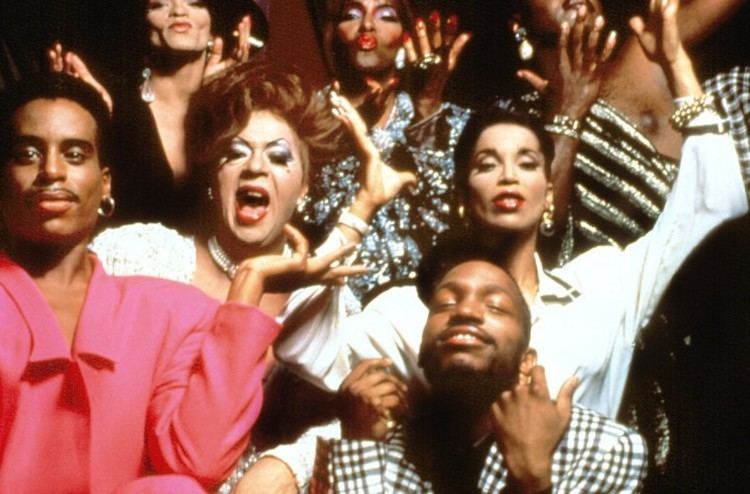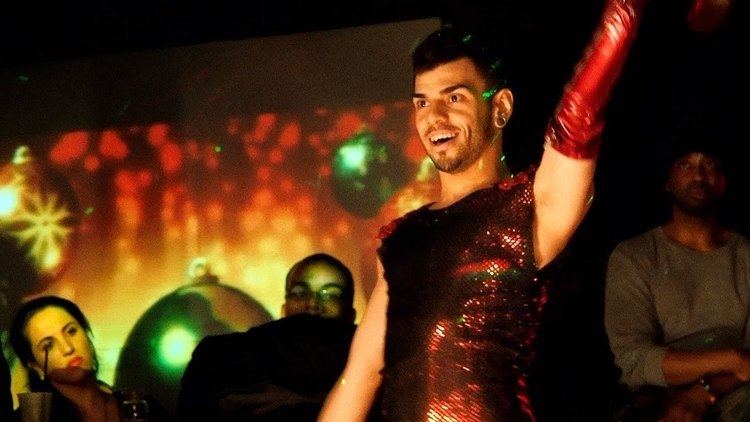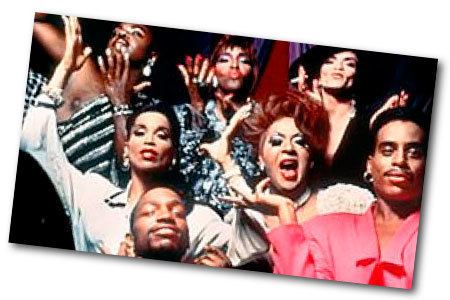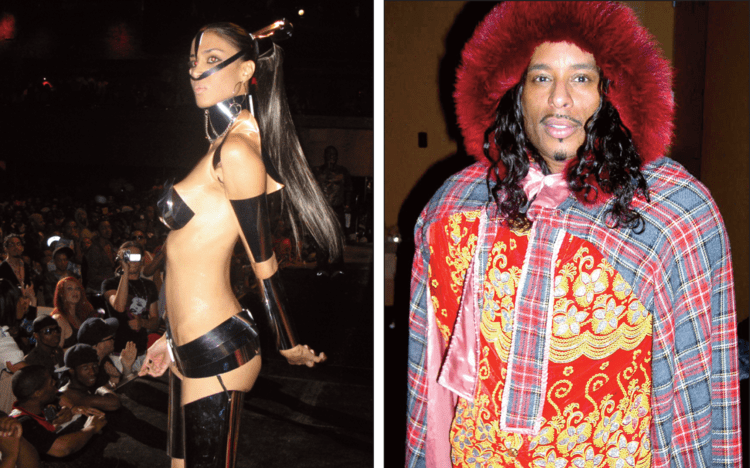 | ||
Vogue knights a short documentary on ball culture in hell s kitchen
Ball culture, the house system, the ballroom community and similar terms describe an underground LGBT subculture in the United States in which people "walk" (i.e., compete) for trophies and prizes at events known as balls. Some who walk also dance; others compete in drag genres, trying to pass as a gender and social class. Most participants in ball culture belong to groups known as "houses".
Contents
- Vogue knights a short documentary on ball culture in hell s kitchen
- Paris is burning cast on the joan rivers show part one
- Houses
- Competition
- Categories
- Runway
- History
- New York City
- Washington DC
- Influences
- Dance
- Language
- Music
- Fashion
- Mainstream entertainment
- Media coverage
- References

Paris is burning cast on the joan rivers show part one
Houses

Houses, also called "families", are LGBTQ+ groups which band together under a "house mother" (sometimes a drag queen or transgender person) or "house father".

According to Bailey (2013), the gender system is a collection of gender and sexual subjectivities that extend beyond the binary categories of dominant society such as male/female, gay/lesbian, man/woman etc. A member chooses to identify with a certain category based on their walk (performance). This system includes six categories: Butch Queens, Femme Queens, Butch Queens up in Drag, Butches, Women, Men and house parents. Those in the women category are primarily straight, feminine lesbians or queer. Overall, the gender system does not completely break from the hegemonic norms of sex, gender and sexuality, but it offers more gender and sexual identities from which to choose.The gender system specially serves to define what role members play in the house. According to Arnold & Bailey (2009), in Ballroom culture, houses are kinship structures that are configured socially rather than biologically. The purpose is to provide a home or gathering place for members. In these houses, such members serve as 'mothers' or 'fathers,' in other words, house parents. The purpose of house parents is to provide guidance for their 'children' of various ages, race, and ethnic background. For example, house mothers perform some of the same 'motherly qualities' such as cooking, cleaning, and being nurturing. On the other hand, house fathers typically serve as the mentors of their 'children.' They provide guidance, uphold the house reputation, and serve as authority figures. For the most part, the division of labor for house parents is very much alike to heteronormative gender roles

Houses across the United States are similar to each other, with most in major cities on the East Coast, the Midwest and the South (House Of Infiniti, House of Mizrahi, House of Aviance and House of Overness).

Other LGBTQ-based families which use the term "house" in their community are neither ball nor pageant houses. Some were created under the Imperial Court System (ICS, founded in California in 1965 with chapters throughout North America), ranging from royal-dynasty-based families (such as the House of St. James) to non-denominational houses (such as the Imperial House of Black, with headquarters in Virginia and chapters throughout the US, Canada, South Africa, Asia and Europe.)
According to the Village Voice:

...houses are loose-knit, typically same sex, confederacies of "children" who adopt a family name, usually swiped from a fashion designer, and adhere to rules set up by a presiding "mother" and "father".
Members of the house led by Willi Ninja, for example, adopt Ninja as their surname; members of the house led by Angie Xtravaganza used the surname "Xtravaganza", and members of the house led by Avis Pendavis use the surname Pendavis. One theme in Paris Is Burning is that people of color, queers and poor people face disadvantages as marginalized groups; to identify as all three may make one an outcast. Drag houses are:
...a whole new way of living, one that's highly structured and self-protective. The structure consists of system of houses where the young men function as apprentices. Reflecting a minority coping with hatred, the houses are associations of friends, presided over by a "mother", [...] that provide a substitute for biological families.
Living under the "house parents" are:
...a big raucous band of "children": drag queens, butch queens, transsexuals—mostly MTF but some FTM, a few non-trans girls and one or two straight guys. The smattering of girls and straight guys notwithstanding, the houses are, essentially, cabals of young black and Hispanic men obsessed with being fashionable and fabulous.
House parents can provide wisdom, guidance and care for young people who otherwise might be homeless. A study of two houses in Newark, New Jersey used qualitative research methods (including participant observation and in-depth interviews):
Strategies employed by "house parents" have had an impact on the choices made by children of the houses regarding HIV risk behaviors. These strategies can be adapted for use by well-established community-based HIV prevention programs when they are comprised of staff who mirror the characteristics of "house parents" and engage in relationships that parallel this alternative family structure.
Kevin Aviance, who appeared in Flawless, The Tyra Banks Show and America's Next Top Model, is a member of the House of Aviance founded 1989 in Washington, D.C.
Competition
In addition to providing a support system for their members, the houses "walk" (compete) against one another in "balls" judged on dance skills, costumes, appearance and attitude. Participants dress according to category in which they are competing, and are expected to display appropriate "realness".
Dominated by hip hop fashion and music, these events are:
...a tradition dating back to the 19th century and going strong into the 21st. Balls continue to be held in bars or Masonic halls or other improbable venues. Across the country and throughout the five boroughs legends are still being born.
Although some competitive walks involve crossdressing, in other cases the goal is to accentuate a male participant's masculinity or a female participant's femininity as a parody of heterosexuality.
Categories
One participant wrote:
There is more to the ballroom scene than chopping, mopping, "fierceness" and shade; and there is more to vogueing than striking a pose. Drag is a form of control. By looking good one can feel good. By looking powerful, one can feel powerful. One can be powerful. Therefore, beauty begets control. Artifice equals power ... Then again, it may just be a bunch of bitches competing for trophies. Either way, its fun. There is of course a distinction between the casual runway that would erupt at a "normal" club, and the formal runway of a ball, where there are judges and prizes and actual vogueing.
The largest balls last as long as ten hours, with dozens of categories in a single evening. With fewer spectators, nearly everyone comes to compete; some trophies are 12 feet (3.7 m) tall, and a grand-prize winner can earn $1,000 or more.
Runway
Within the runway, there are various forms of performance in which performers are judged on such as 'voguing,' runaway walking and other categories. Voguing started as drag pageants, but has now expanded to include specific categories:
The Vogue form of dance can be broken into five different components that can be used in a ball:
Another component of performance is the Runway. There are two types of runway walking:
In addition to runway and components of the actual performance, members of the ball scene are judged on various other categories:
History
As a countercultural phenomenon, ball culture is rooted in necessity and defiance. The ballroom culture has existed for at least five decades. However, it remains largely underground and unknown for this particular community of blacks and Latinos/as. It began in Harlem more than 50 years ago, and has now expanded rapidly to other major cities such as Chicago, Atlanta, Baltimore, Charlotte, Cleveland, Detroit, and Philadelphia. Moreover, with the advancements of social media, it has migrated to other countries such as Canada, Japan, and the UK (Bailey, 2013). Ball culture also known as "house ball culture," was first captured in Jennie Livingston's documentary, Paris is Burning (1990).
New York City
As told by Pulitzer Prizewinning author Michael Cunningham, New York City's ball culture is the product of:
...the underground drag balls that had been going on in and around New York City since the thirties. Those balls were merely drag fashion shows staged by white men two or three times a year in gay bars, with prizes given for the most outrageous costumes. Black queens sometimes showed up but they were expected to whiten their faces and they rarely won a prize.
During the 1960s black drag queens began hosting events in Harlem, where they took the concept to:
...heights undreamed of by the little gangs of white men parading around in frocks in basement taverns. In a burst of liberated zeal they rented big places like the Elks Lodge on 160 West 129th Street, and they turned up in dresses Madame Pompadour herself might have thought twice about. Word spread around Harlem that a retinue of drag queens was putting together outfits bigger and grander than Rose Parade floats, and the balls began to attract spectators, first by the dozens and then by the hundreds, gay and straight alike. People brought liquor with them, sandwiches, buckets of chicken. As the audiences grew, the queens gave them more and more for their money. Cleopatra on her barge, all in gold lamé, with a half dozen attendants waving white, glittering palm fronds. Faux fashion models in feathered coats lined with mylar, so that when the coat was thrown open and a two-thousand-watt incandescent lamp suddenly lit, the people in the first few rows were blinded for minutes afterward.
Participants in these balls split into factions led by influential, charismatic figures:
In 1977 an imperious, elegant queen named Crystal LaBeija announced that a ball she'd helped put together was being given by the House of LaBeija, as in House of Chanel or House of Dior. It was a p.r. gimmick, something to add a little more panache and, not incidentally, to increase the luster of Crystal LaBeija. The concept caught on, and suddenly every ball was being given by a house. Some queens named their house after themselves, like Avis Pendavis' House of Pendavis or Dorian Corey's House of Corey. Others took the names of established designers like Chanel or St. Laurent. [...] By the early eighties younger, less experienced drag queens were declaring themselves members of this house or that house, and competing in balls under the house name. Some went to court and had their last names legally changed, to Pendavis or Corey or Chanel or St. Laurent. [...] Houses came to be ruled by their biggest stars, who were known as mothers and who exhorted their members—their children—to accumulate as many prizes as possible for the greater glory of the house.
In 1989, The House of Latex was created as a call to action in the ballroom community to bridge the gap between HIV-STI prevention and ballroom culture. The best-known House of Latex leaders were Arbert Santana Latex/Evisu, who died on March 3, 2011 (Big Boys Runway), and Aisha Diori Latex/Prodigy (Legendary Women's Face); both educated, provided a safe space and inspired lesbian, gay, bisexual and transgender youth of color involved in the ball scene.
Born in a 1989 collaboration between GMHC and members of the ballroom community concerned about the increase of HIV and AIDS in the ball scene, the House of Latex was committed to outreach and prevention (primarily among LGBT youth of African American and Latino descent) for over 20 years. The name "Latex" was bestowed by the community because one of the house's primary functions is to distribute condoms at balls and other events. Most other houses are named after designers or community members. HOL became an official "house" in 1993, and held its first annual ball (which developed into one of the largest events in the New York City ballroom community).
A memorable Latex Ball theme was "The Latrix", a pun on The Matrix. Aisha Latex Prodigy, founder of the WBT House of Iman, explained that the theme was chosen because the film's day-to-day "reality" is a façade created by machines controlling the real world. This relationship, she said, parallels public attitudes toward the "machines" of HIV and AIDS (instead of fighting back, with prevention and education). Truth is denied, and the disease's authority is passively accepted. The Latrix, the evening's program explained, allowed members of the ballroom community to tackle issues such as racism, homophobia, sexism, transphobia, HIV and AIDS by competing and sharing their talents and creativity with the community. "Our chances lie in the acknowledgement of these issues," the program read. "If we free our whole community we can survive. There is hope." "The House of Latex works in partnerships", stressed Arbert Santana. "Our partnerships with other agencies are very important." HOL's partners include People of Color in Crisis and Gay Men of African Descent, who were present to distribute literature and safe-sex packets. The David Geffen Testing Center at GMHC provided free HIV testing.
In addition to its annual ball, HOL "walks" balls throughout the year, handing out educational pamphlets and safe-sex packets; does outreach on the streets and in clubs, and provides peer space for LGBTQ youth by holding discussion groups, or "House Talk," twice a month. Santana explained that HOL specifically focuses on youth of color between the ages of 15 and 25: "If we are able to provide intervention at an earlier age, we can stop the spread of HIV and AIDS." The House of Latex has changed its direction from a walking house to a service and drop-in resource for the LGBTQ house ballroom community since Aisha Latex implemented the KiKi Ballroom initiative, targeted at LGBTQ youth and young adults in the mainstream ballroom scene. The Kiki ballroom scene is being replicated nationwide by a number of community organizations.
Washington, D.C.
This account from the metropolitan Washington, D.C. area describes how ball culture and drag houses developed about 1960:
Some regular house parties became institutionalized as drag "houses" and "families." The leader, or "mother," often provided not only the opportunity for parties but also instruction and mentoring in the arts of make-up, selecting clothes, lip-synching, portraying a personality, walking, and related skills. Those taught became "drag daughters," who in turn mentored others, creating entire "drag families." Drag houses became the first social support groups in the city's gay and lesbian community. House names often came from addresses of the house 'mother', such as Mother Billy Bonhill's Belmont House at 15th and Belmont NW, or associations with the "mother's" chosen personality, as Mame Dennis's Beekman Place.
The dance styles which later characterized drag houses had not been developed; competitions between houses involved standard drag performances in which entertainers lip-synced or, rarely, sang. In contrast to the New York houses in Paris Is Burning, some of the Washington, D.C. house mothers were white. However, African-American drag queens were a prominent part of the community:
Venues for drag shows and competitions were a constant challenge in the 1960s. The Uptown Lounge sponsored monthly drag contests, an event later duplicated at Johnnie's on Capitol Hill. Chunga's drag shows at the Golden Key Club in North Beach, Maryland were a popular Sunday event. The major hotels' resistance to drag events was not broken until February 1968 when African-American drag impresario Black Pearl staged the gala Black Pearl International Awards at the Washington Hilton. It was the drag event of the year.
The Washington, D.C. ball community consists primarily of African-American and Latino participants, and has adopted many attributes seen in Paris Is Burning. Nineteen-sixties-style drag shows and competitions still exist, with their own audience. Ball patrons will find similar categories (such as "banjee thug realness" and "vogue") as an audience member.
The Washington ballroom scene was founded in 1986 by Icon Lowell Adonis-Khanh (Lowell Thomas Hickman) and Icon Eric Christian-Bazaar. During the 1990s, more houses appeared in the area due to the efforts of Twain Miyake-Mugler ("father" of the House of Miyake Mugler, D.C. Chapter), Legendary Shannon Garcon and Legendary Whitney Garcon (founders of the House of Garcon and charter members of The Legendary House of Miyake-Mugler, D.C. Chapter). The city hosts a series of annual balls, in which contestants compete for trophies and cash prizes.
Houses in the D.C. area include the House of Khanh, the House of Balenciaga, the House of Comme des Garcon, the House of Miyake Mugler, House of Ebony, the House of Milan, the House of Evisu, the House of Prodigy, the House of Revlon, the House of Allure, the House of Manolo Blahnik and the House of Xcellence. Kevin Aviance, whose appearances include Flawless, The Tyra Banks Show and America's Next Top Model, is a member of the House of Aviance (founded in 1989).
Influences
New York's legendary Ballroom Culture has been a huge inspiration for performers since the 1980s, all the way up until today. Central to the balls are extravagant pageantry and voguing— a form of angular, improvisational and competitive dancing that can be compared to break dancing— which reached mainstream popularity through Madonna's 1990 hit "Vogue". (Today, the debate lingers as to whether people like Madonna were important ambassadors for gay Latino and black men within the ballroom scene, or merely opportunists who pilfered the culture for their own benefit and moved on.) More recently, a group called House of LaDosha, a dance-rap and performance group in Brooklyn, showcases fringe artists from almost every type of genre. However, they all have a few things in common: they are wildly flamboyant, mostly dressed in drag, and determined to keep up the high energy all night. Hip-hop's identity seems to be pulling heavy inspiration from Ballroom Culture today, more than ever. There are rappers like A$AP Rocky or Soulja Boy that are harkening back to hip-hop's earlier days and labeling themselves "pretty." There is Nicki Minaj's decision to stage high-budgeted, flamboyantly costumed performances consistently on national television. For the first time ever, XXL even listed a woman in the 2012 edition of their annual list of hip-hop freshmen.
Zebra Katz, an American rapper, is widely known for his 2012 breakout single "Ima Read." The music video for "Ima Read" shows a sort-of grey-washed dystopia take on a private school where masked, gender-neutral figures sporting school-girl outfits and waist-length braids haunt abandoned hallways. Meanwhile, Kantz portrays a school teacher, marking big red F's on papers, chanting, "I'ma read that b*tch/ I'ma teach that b*tch/ I'ma take that b*tch to college/ I'ma give that b*tch some knowledge/ I'ma read/ I'ma read/ I'ma read…" Zebra Katz explains, "It's a fine line that I'm playing here. I'm trying to see how cleverly I can walk a tightrope… You have [fans from] the ball culture," he says, "And then you have hip-hop heads who are gonna say this is 'hard' because it's very minimal and to-the-point."
To the average listener, "Ima Read" comes off as a twisted pro-education anthem. According to Kantz, in some ways, it is. However, ultimately it is a bow to Ballroom Culture. Throughout the entirety of the song, he consistently raps, "I'ma read/I'ma read/I'ma read," which is a reference to the vogue slang "reading," which is to verbally insult someone on the dance floor. Sometimes the ballroom references made by this wave of rappers are as blatant and simple as naming a song "Ima Read" or tagging song uploads with "vogue" and other related terms. However, there are deeper and more understated roots that connect to a lineage of communal cultural experiences shared by gay African Americans and Latinos in New York City.
Le1f, aka Khalif Diouf, the wunderkind rapper and producer comments on Ballroom Culture, "When I first found out about voguing as a teenager, it was an eye-opening experience because it felt like an innate way of moving. And a lot of my music is made with the intentions of movement and dance… But it's the cultural side-- the experience of being at a ball-- that's affected what I rap about. The fact that there's a scene that's existed for so long with such a rich history, and is ceremonial, is really nice." He also added, ""It's also just a community of people who are so liberal and devoted to making good art, often collaboratively."
Chantal Regnault, director and photographer, released gorgeous photo book "Voguing and the House Ballroom Scene of New York 1989-1992" in 2011. It includes a quote from black cultural critic Frank Leon Roberts, "A rich taxonomy of gender personas and identities flooded in: thugged-out hustlers who were 'new' to gay culture, butch lesbians with erotic attachments to gay men, bootleg black designers and fashionistas eager to put their garments 'to test' in a new urban scene."
Dance
The most notable influence of ball culture on mainstream society is voguing, a dance style originating in Harlem ballrooms during the first half of the 20th century and popularized by the video for Madonna's Vogue released in 1990 (the same year as Paris Is Burning). According to one source, "Many people only know of underground ballroom culture from Madonna's 'Vogue' or the film 'Paris Is Burning'." The dance group Vogue Evolution, from America's Best Dance Crew, has again sparked interest in voguing.
Language
Ball-culture terms are sometimes used more generally; "drag mother" may apply to any drag queen in a mentorship role, and "drag house" may refer to a group of drag performers allied personally or professionally. "Fierce" and "fierceness," "work it" and "working it," "fabulous" and "fabulousness" are heard in Paris Is Burning and appeared in the lyrics of "Supermodel (You Better Work)", a 1992 hit by drag queen RuPaul. These terms became more widely used in gay slang, fashion industry jargon and mainstream colloquial language.
Music
Ball culture has been fertile ground for new forms of house music and other genres of electronic dance music through its DJs. The culture has also influenced a wave of queer hip hop artists.
Fashion
Ball culture has influenced "the über-puffed-up peacock sexuality" of contemporary mainstream hip hop. A professor at New York University professor said about gay black culture, "Today's queer mania for ghetto fabulousness and bling masks its elemental but silent relationship to even more queer impulses toward fabulousness in the 1960s and 1970s."
Mainstream entertainment
In 2006, Beyoncé Knowles told a reporter from The Independent "how inspired she's been by the whole drag-house circuit in the States, an unsung part of black American culture where working-class gay men channel ultra-glamour in mocked-up catwalk shows. 'I still have that in me', she says of the 'confidence and the fire you see on stage ... '"
Media coverage
Most of the New York-based houses appeared in the 1990 documentary film, Paris Is Burning. The 2016 film Kiki also provided an updated portrait of the ball culture scene.
